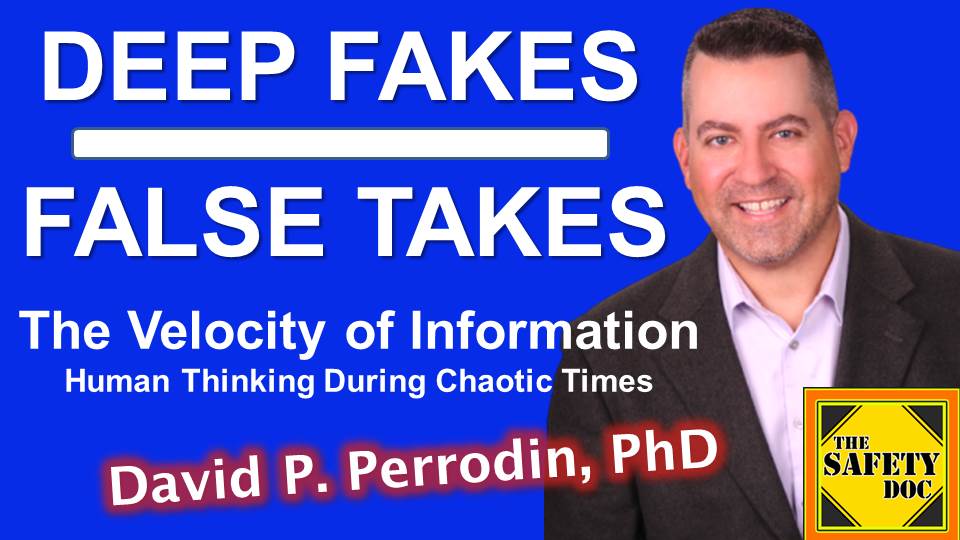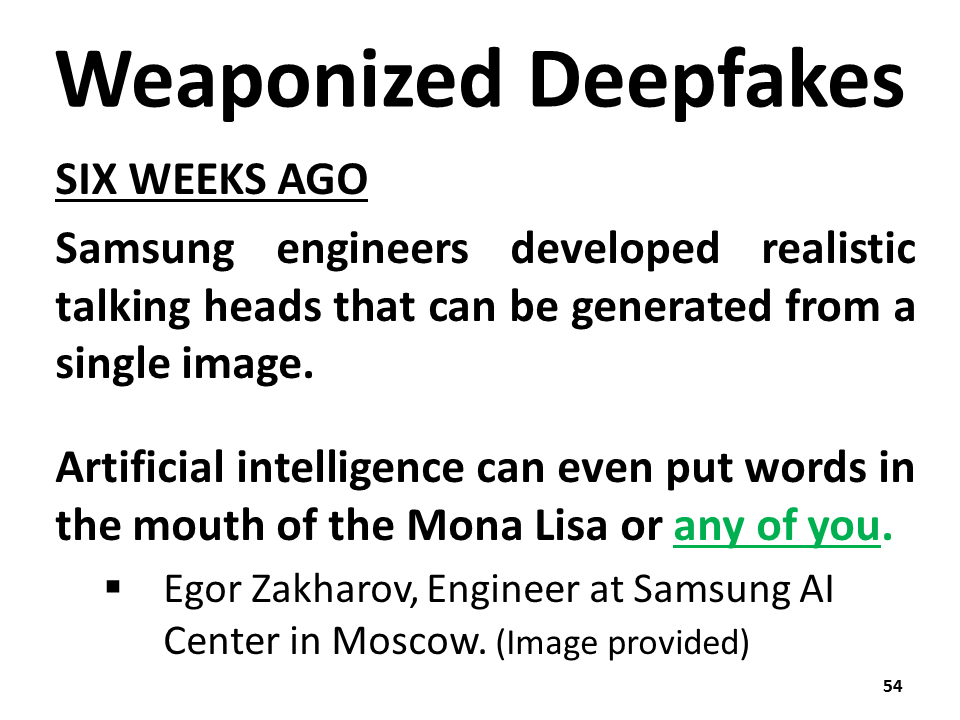Deep Fakes and False Takes | The Velocity of Information | David P. Perrodin | SDP176
[Podcast] In June, 2019, U.S. lawmakers held their first hearing devoted primarily to the threat of artificially generated imagery. Then in October, 2019, California banned political deep fakes during election season. But, such actions have raised questions. What might be consequences looming at the intersection of deep fakes and public policy?

DIRECT LINK to MP3 of this Episode: https://tinyurl.com/SDP176-AUDIO
WHAT ARE DEEP FAKES? Per Tim Biggs and Robert Moran of Explainer, “Deep fakes are the most prominent form of what’s being called ‘synthetic media’: images, sound and video that appear to have been created through traditional means but that have, in fact, been constructed by complex software. [D]eep fakes are, in their most common form, videos where one person’s face has been convincingly replaced by a computer-generated face, which often resembles a second person.” Deep fakes, which came to prominence in 2017, can be of a single person or people.
RISKS OF DIGITAL DEEP FAKES. Digital deep fakes could rapidly erode trust in people’s main source for information – the Internet. Deep fakes will damage reputations, end careers, and cause people to be skittish and hesitant to trust most media sources. Deep fakes could fuel civil unrest and toss dust in the eyes of stressed citizens anticipating negative news as they plot high-stakes next steps in order to navigate war-torn landscapes. Furthermore, anyone can be the target of this technology. We have to play defense and offense. How do you prove your innocence against a convincing deep fake that portrays you as a fraud or of association with their ilk?

FIND THE TRUTH. The following are excerpts from pages 69-70 from the book ‘The Velocity of Information: Human Thinking During Chaotic Times.’ “In any investigation, the goal is to find the truth, not to confirm suspicions or predetermined positions. If you approach panic-inducing situations with that attitude, you will arrive at awareness, rather than panic. Your initial assumptions and conclusions may not always be correct.”
THE PACKED STADIUM – OR IS IT? “[I]magine watching a professional baseball game on TV and texting your attending-in-person friend, “Stadium is packed! Hope the concession lines aren’t a mile long!” Seconds later, they respond with a wide-angle selfie from a bleacher seat, “What are you talking about? This place is practically empty!”
FOX SPORTS’ DIGITAL FANS. “On July 23, 2020, Fox Sports posted a thirty-seven-second video to its Twitter account demonstrating how it would place thousands of virtual lifelike fans in the stands of major league stadiums (1). “Fox Sports producers will be able to control things like how full the virtual ‘crowds’ are for a given game, what weather fans are dressed for, and what percentage of the crowd will be home fans versus away (2).” The crowds appeared strikingly authentic and would be indiscernible from real crowds to most TV viewers. That snippet was both incredible and chilling at the same time.”
HACKED REALITY? “What other real-world scenarios could be “hacked” to distort crowd density? Political rallies, protests, lines outside stores? Is there an app for that?”
CITATIONS: (1) Fox Sports. [@FoxSports.] “No Fans? Not on FOX Sports. Thousands of Virtual Fans Will Attend FOX’s MLB Games This Saturday.” Twitter. July 23, 2020. https://twitter .com /FOXSports /status /1286281346390740993. (2) Gartenberg, Chaim. “How Fox Sports Will Use Virtual Fans Created in Unreal Engine to Fill Empty Stadiums in MLB Broadcasts. Real Sports, Fake Fans.” The Verge. July 25, 2020. https://www .theverge .com /2020 /7 /25 /21336017 /fox -sports-baseball -virtual -fans -epic -unreal -engine -empty -stadiums -mlb.
This is episode 176 of The Safety Doc Podcast published on 04-05-2022. This podcast and blog post represent the opinions of David P. Perrodin and his guests to the show. The content here is for informational purposes only. Please consult with your safety professional regarding the unique needs of yourself or your organization.
FOLLOW
- Watch this episode on “The Safety Doc” YouTube channel https://tinyurl.com/SDP176-VIDEO
- Listen to this episode on PodBean MP3 https://tinyurl.com/SDP176-AUDIO
- Apple Podcasts http://tinyurl.com/SafetyDocApplePodcasts
- SAFETY DOC WEBSITE & BLOG safetyphd.com
- Follow David & The Safety Doc Podcast on Twitter @SafetyPhD
- Email Dr. Perrodin thesafetydoc@gmail.com
Purchase Dr. Perrodin’s books
School of Errors – Rethinking School Safety in America
The Velocity of Information – Human Thinking During Chaotic Times
